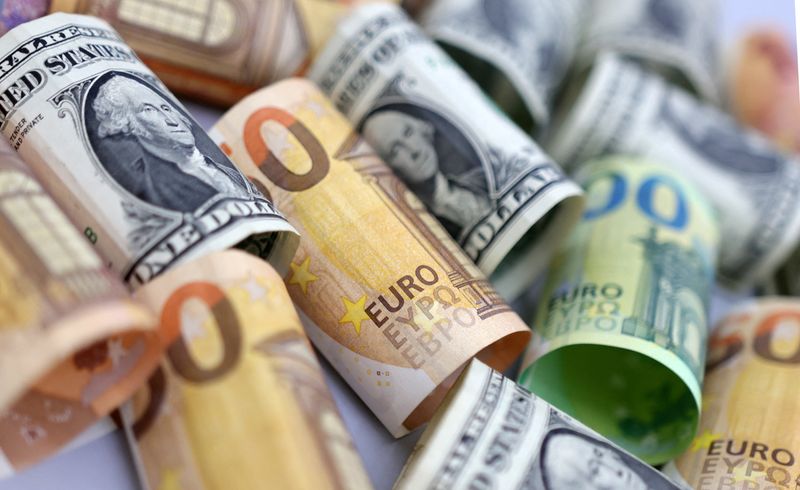By Herbert Lash and Stefano Rebaudo
NEW YORK (Reuters) -The dollar slid against major currencies on Tuesday, a day after it rose to its highest level in almost three months, as strong economic data and a hawkish stance on interest rates by Federal Reserve officials bolster the U.S. currency.
Robust U.S. economic data, including a blowout unemployment report on Friday, and recent remarks from Fed Chair Jerome Powell have quashed speculation about early and steep rate cuts that the market had widely expected from the U.S. central bank.
Cleveland Fed President Loretta Mester said on Tuesday that if the U.S. economy performs as she expects, it could open the door to rate cuts. But Mester said she was not ready to provide timing for easier policy amid ongoing inflation uncertainty.
Other central bankers agreed. The European Central Bank doesn't need to rush cutting rates, policymaker Boris Vujcic told Reuters, arguing it will be better for ECB credibility to be sure that inflation is decisively under control.
The dominant storyline for FX traders is a return to the U.S. economic exceptionalism trade from the third quarter of 2023, said Matthew Weller, global head of research at FOREX.com.
"Now traders are wondering if instead of whether we'll get a soft landing or recession, whether we could have no landing or re-acceleration this year," he said. "To me it is a lot about the U.S. dollar, the Fed and the economic data that we're seeing out of the U.S."
Traders are currently pricing in a 19.5% chance of a cut in March, the CME Group's (NASDAQ:CME) FedWatch Tool shows, compared with a 68.1% chance at the start of the year.
They are also now pricing in around 117 basis points (bps) of cuts by the end of 2024, compared with around 150 bps anticipated in early January.
The dollar index, which measures the U.S. currency against six others, fell 0.24% to 104.19, after touching 104.60 on Monday, its highest since Nov. 14.
Key to understanding the dollar's strength are Fed policy decisions versus those of other central banks, and how high rates stay, as higher yields can bolster a currency.
"The real debate is not if the Fed cuts a few weeks sooner or later, but if it cuts by less or more than the rest of the world over the next two years," said George Saravelos, global head of forex research at Deutsche Bank.
"We continue to see the risks skewed towards less Fed easing and therefore in favor of the U.S. dollar," he added.
The euro was up 0.09% at $1.0751.
German industrial orders unexpectedly jumped in December, while euro zone consumers have trimmed their expectations for inflation over the next 12 months.
"A potential repricing of the ECB (European Central Bank) policy path towards a first rate cut in June instead of April, which we regard as likely, would prop up the euro in the medium term," said Roberto Mialich, forex strategist at UniCredit.
The Reserve Bank of Australia (RBA) earlier on Tuesday left rates unchanged, but cautioned about a possible further monetary tightening.
The Aussie rose 0.59% at $0.6520, inching away from the 2-1/2 month low of $0.6469 it touched on Monday.
The repricing of the RBA monetary path "helps to provide modest support for the Australian dollar in the near-term," said Lee Hardman, senior currency analyst, at MUFG.
"Sentiment towards the Aussie has also been boosted indirectly overnight by the rebound in the Chinese equity market where speculation is building over further state policy action to provide stability," he added.
Sterling rose 0.50% at $1.2593, up from a seven-week low on Monday.
The pound's fall on Monday came despite some upbeat economic data. Figures showed that UK unemployment was likely much lower late last year than previously thought, which could push out British rate cuts too.
The Japanese yen was stronger on the day, up 0.20% at 148.67 per dollar, a bit off from a two-month low of 148.90.

Japan's real wages fell for a 21st straight month, though at a slower pace, while household spending dropped for a 10th consecutive month, showing inflation outpaced wage recovery and continued to weigh on consumer spending.
Bitcoin rose 1.78% to 43,088.59